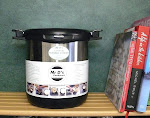 Last night I didn't use the Shuttle Chef as we still had some of the Biriani left so I have decided to add my recipe for Master Stock.
Last night I didn't use the Shuttle Chef as we still had some of the Biriani left so I have decided to add my recipe for Master Stock. Master stock refers to an aromatic, reusable stock used a lot in Cantonese cooking. Once the base stock has been prepared it is then used as a poaching or braising liquid for meat. Chicken is the most common meat cooked in master stock, although duck and pork are also often used.
I have read that in some restaurants in Beijing use master stock that is over 100 years old and it is a wonderful thought that maybe flavours that were created all those years ago are being handed down from generation to generation.
My stock is fairly new and I don't know if in a hundred years someone will still be cooking chicken in it but I do know it gives food a divine texture and flavour.
KEEPING THE STOCK: After use, if the master stock is not be immediately reused it should be boiled, skimmed, strained and cooled quickly to minimise the potential for bacterial growth. The stock should then be refrigerated or frozen until required. Refrigerated stocks may be kept for up to three days, while frozen stocks may be kept for up to a month. If the stock is to be kept longer it must be boiled before being reused.
THE INGREDIENTS:
- 2 L Water.
- 4 Cloves Garlic Sliced.
- 4cm piece of Ginger sliced.
- 6 spring onions chopped in half.
- 1 piece of cassia bark (you can substitute cinnamon stick for this).
- 3 star anise.
- 3 pieces of dried orange peel. You can buy this at an Asian supermarket or peel an orange (without the white pitch as this is bitter) and dry it slowly in the oven on a very low heat.
- 250 ml light Soy sauce.
- 250 ml Shoaxing wine (Chinese cooking wine).
- 75 g Chinese rock sugar (granulated sugar can be used ).
Replenish the stock with fresh garlic, ginger, shallots and aromatics each time you use it and the flavour will continue to intensify in strength and flavour.







No comments:
Post a Comment